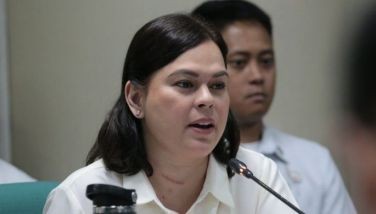Survivors find hope and healing
MANILA, Philippines - “It is like being trapped in a dark cave or tunnel with no light or end in sight.” This was how Marian, (not her real name) 27, of Matalam, North Cotabato, describes her ordeal as a victim of an illegal recruitment syndicate.
“They promised me a good job, and since I wanted to provide the best for my child, I believed them,” she says.?
“I was so happy when my recruiter informed me that I was finally leaving…but little did I know that my journey to hell had just begun.”
Marian, along with more than 50 girls and women, was smuggled to Malaysia. Upon their arrival, they were promptly arrested by the Malaysian Police, and thus began their harrowing experience in jail.
“Sa loob ng tatlong buwan, natulog kami sa malamig na semento, wala man lang kumot na panangga sa lamig, at pinapakain kami ng panis na pagkain. Dala ng hirap na dinanas ko, nagkasakit ako nang malubha, akala ko mamamatay na ako dun, mabuti na lamang at binuhay pa ako ng Panginoon upang makabalik sa aking pamilya (For three months, we slept in the cold cement floor without even a blanket to keep us warm. We were given rotten food. Because of the harsh conditions, I fell gravely ill, and thought I was going to die there, Thanks to God, He gave me another chance to live and so I could go back to my family) Marian shares. ?
According to Rosemarie Alcebar, social worker and member of DSWD Region 12 Social Welfare and Development team (SWAD), Marian was rescued in December 2011.
Marian is currently being assessed and continues to undergo critical incident stress debriefing (CISD) and counselling to help her lead a normal life again. “When she is ready, Marian will be provided with livelihood assistance which will help her recover from her trauma and keep her busy while regaining her self-esteem, and earning on the side” Alcebar says.?
On the other hand, Fatima, 16, and Farida, 17, both from Matalam; and 17-year-olds Noraida and Tamara, from Kabacan and Pikit, respectively, all in North Cotabato, feel fortunate that they were intercepted before they could leave the country.
Fatima was barely 14 when they were recruited two years ago. The four minors together with 12 others were intercepted by the National Bureau of Investigation which referred them to DSWD Region 12 and to member-agencies of the Inter-Agency Council Against Trafficking for pre-return/return services.
All four said that the desire to help their families was the main reason why they wanted to work abroad. They also admitted that they were the ones who sought the recruiters who agreed to fake their ages so they could work abroad.
Amina Dataya, head of the Social Technology Unit and focal person on Recovery and Reintegration Program for Trafficked Persons of DSWD Region 12, which helps and refers victims of trafficking to appropriate agencies for intervention, says “poverty is the reason why young and vulnerable girls like Fatima, Farida, Noraida and Tamara are lured into working abroad even without assurance of their safety. They dream of a better life for their families and themselves, hence, are willing to lie about their age so they could work abroad mainly as domestic helpers.”
After 15 days at the center, they were reintegrated with their families. Dataya assures the four girls continue to be provided with psycho-social interventions, such as continuous counseling, stress management, family counseling, and group sharing sessions, among others.
Each of them also received P3,000 so they could start a small livelihood enterprise, like a sari-sari store.
The girls have seemed to have moved on. Fatima is currently in third year high school at a public school, while Farida, Noraida and Tamara help their parents tend the sari-sari store they have put up from the livelihood assistance provided to them.
“We want to go back to school to continue our education, and maybe someday, when we are adults, we will finally achieve our dream to work abroad to have a better life,” the girls say.
Marian, however, even after a year has passed, finds it more difficult to move on.
“Minsan, hindi ako makatulog, naiisip ko yung mga masasamang nangyari sa akin, minsan natutulala na lang ako (Sometimes, I can’t sleep thinking of all the bad things that happened to me, sometimes, I just stare blankly into space).” Likewise, Marian has not yet regained her health which has deteriorated as a result of her harrowing experience.
“Being at sea in stormy weather and the injuries she has incurred in jail have affected her health… she even has to be operated on,” Alcebar reports.
Despite this, she and the other social workers helping Marian are hopeful that she will eventually heal physically and emotionally.
“We are doing everything we can to help her. We always tell her, think of your child, he needs you so you must try to overcome your negative experience and focus on recovery.”
Social workers, indeed, play a vital role in the recovery and healing of trafficked victims.
“I want to finish my studies and be a social worker someday, like Ate Rose” says Fatima. “She and the other social workers in DSWD Region 12 and the Municipal Social Welfare and Development Office (MSWDO) have encouraged, inspired and given me hope that truly, there is light at the end of the tunnel,” she says.
In the fight against human traffickers, social workers actually endanger themselves.
This commitment and courage to help victims of trafficking is also shared by Nelia Ignacio, head of Home for Girls.
“I often feel sad and angry that these girls are being lured by unscrupulous traffickers. In most instances, it is their parents who push their innocent children to work abroad because of poverty. They do not realize the dangers that await their child in a foreign country,” she says.
“When they first arrived here, they were scarred, scared, bitter and angry, especially the ones who were forced to work in the white slavery trade abroad. It took me and the other social workers some time to gain their trust and confidence,” Ignacio adds.
“Here at Home for Girls, we invite trainors to teach cosmetology and hair science, because we found out that some of our other activities, such as art or play therapy are not suitable for trafficked victims. They want to learn a trade which they could use when they are fully recovered and reintegrated to their families and communities.”
Home for Girls provides a wide range of services for the protection and rehabilitation of girls, aged 7-18. The center also aims to protect the girls from further neglect, abuse and exploitation; provide self-enhancement and social enrichment activities, and effect linkages with other agencies and organizations.
Meanwhile, Joanne Macagba, focal person for trafficking in Pikit, North Cotabato used a different strategy to counter trafficking in their municipality. “I was alarmed since we had 10 trafficking cases in 2010-2011, mostly involving minors. I called for a meeting with all the legal recruiters in the area, got all the names of the persons they recruited, and explained to them the consequences of recruiting minors.”
“The recruiters were also required to shoulder the traveling expenses for all recruits being trafficked and for expenses to be incurred during their reintegration to their parents,” Macagba adds.
During the meeting with Pikit local officials, it was recommended that recruitment agencies should be required to get a certification from the MSWDO for eligibility of the applicants to work abroad and to submit deployment status report to the Public Employment Services Office (PESO).
This strategy seems to have worked since trafficking cases in the area dropped dramatically.
Recently, the Philippines was upgraded from Tier 2 Watch List to Tier 2, proof that while human trafficking continues to be a problem, steps are taken to improve the situation.?
During the IACAT meeting which discussed the 2012 Global Trafficking in Persons (GTIP) report, it was emphasized that President Aquino expected the Philippines to reach Tier 1 in two years, a huge challenge to the council.?
According to Social Welfare and Development Secretary Dinky Soliman, the Philippine government began designing a national strategy to prevent trafficking in women and children after an alarming number of cases surfaced in 1996.
These measures included the creation in 2000 of an Executive Council to coordinate the activities of all concerned agencies, and the creation of the Philippine Center on Transnational Crime (PCTC) in 1999.
The PCTC maintains a database that government agencies share for information on criminals, arrests and convictions for transnational crimes, including trafficking in persons, illegal recruitment, intermarriages and overseas employment. ?
Aside from the DSWD’s rehabilitative and protective programs for victims of trafficking, the DSWD also assigned social workers at major airports nationwide as well as in various ports to detect and assist possible victims of trafficking.
This is how the minors from Cotabato were intercepted and referred to an affiliate NGO and DSWD Region 12. ?
“We are hopeful that through the continuous implementation of poverty reduction programs, such as Pantawid Pamilyang Pilipino, Kapit-Bisig Laban sa Kahirapan, Comprehensive and Integrated Delivery of Social Services and Sustainable Livelihood, poor families will soon find economic relief that will eventually save them from the claws of human traffickers,” said Secretary Soliman.
- Latest
- Trending


















